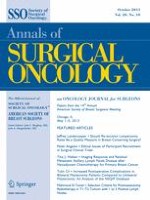Erschienen in:

01.10.2013 | Breast Oncology
Selection Criteria for Postmastectomy Radiotherapy in T1–T2 Tumors with 1 to 3 Positive Lymph Nodes
verfasst von:
Tracy Ann Moo, MD, Robert McMillan, MD, Michele Lee, BA, Michelle Stempel, MPH, Sujata Patil, PhD, Alice Ho, MD, Mahmoud El-Tamer, MD
Erschienen in:
Annals of Surgical Oncology
|
Ausgabe 10/2013
Einloggen, um Zugang zu erhalten
Abstract
Background
Postmastectomy radiotherapy (PMRT) is well established in patients with ≥4 positive axillary lymph nodes (ALN); indications in 1 to 3 positive ALN remains controversial. We examined clinicopathologic criteria used for PMRT selection and compared locoregional recurrence (LRR), recurrence-free survival (RFS), and overall survival (OS) among patients with and without PMRT.
Methods
Between 1995 and 2006, a total of 1,331 patients with T1–T2 tumors and 1 to 3 positive ALN underwent mastectomy. We excluded T3/T4 tumors and neoadjuvant chemotherapy; we analyzed 1,087 patients (924 without PMRT, 163 with PMRT). Chi square testing compared clinicopathologic features between groups. The Kaplan–Meier method and Cox regression analysis examined the association between PMRT and LRR, RFS, and OS.
Results
PMRT patients were more likely to be ≤50 years old (p = 0.001) and to have larger tumors (p = 0.01), disease of a higher histologic grade (p = 0.03), lymphovascular invasion (LVI) (p < 0.0001), a greater number of positive ALN (p < 0.0001), extranodal invasion (p < 0.0001), and macroscopic ALN metastases (p < 0.0001). With a median follow-up of 7 years, PMRT and no-PMRT groups were similar in LRR (p = 0.57), RFS (p = 0.70), and OS (p = 0.28). On multivariate analysis of the no-PMRT group, age ≤50 years (p = 0.002) and presence of LVI (p < 0.0001) were associated with LRR. Stratified by age and LVI, patients ≤50 years old and with LVI had the highest 5-year LRR, 10.1 versus 1.1 %, than in patients >50 years old without LVI (p < 0.001).
Conclusions
By using clinicopathologic features, clinicians delivered PMRT to a select group of patients with T1–T2 tumors and 1 to 3 positive ALN, resulting in similarly low rates of 5-year LRR. Among patients not receiving PMRT, age ≤50 years and LVI were associated with increased LRR rates and warrant PMRT consideration.